Telescope Buyer's Guide
by the Prairie Astronomy Club, Inc
P. O. Box 5585
Lincoln, NE 68505-5585
Note: please also check out our Youtube video on How to Buy a Telescope.
Amateur Astronomy is one of the most fascinating hobbies in the world, but to get really into it, you probably will want to get a telescope either for yourself or perhaps for a son or daughter who is showing an interest in the wonders of the universe. Somehow, you will have to find your way through the maze of ads, catalogs, claims and counterclaims about which telescope is best or the least expensive. You may be asking yourself questions like “What type should it be?”, or “Just what should I believe when I read the ads?”. Finally, you will have to lay out the cold hard cash needed to purchase what you hope will be the best instrument your money can buy. If you are a bit confused or frustrated at this point, don’t worry. We of the Prairie Astronomy Club know exactly how you feel, because we have all gone through this many times before. This article should help answer many of the questions you may have about purchasing a telescope as well as clearing up some of the mysteries about astronomical telescopes in general. It was assembled by our club members using the many years of experience they have in selecting, buying, building, and using telescopes. They all had to buy that “first telescope”, and hopefully, you can benefit from their hindsight.
TELESCOPES IN GENERAL: A telescope has two main functions: (1) to gather and focus a large amount of light from an object (much more than the eye alone can) to form an image of the object, and (2) to magnify that image so that distant objects can be better seen. There are many different designs of telescope that will accomplish these functions but only two designs are practical for small inexpensive telescopes: the refractor and the Newtonian Reflector. A refractor (figure A) focuses light by “refracting” or bending it through a special two element glass lens. A reflector (figure B) focuses light by reflecting it off a curved mirror. A set of lenses known as the Eyepiece then magnifies the focused image in each design.
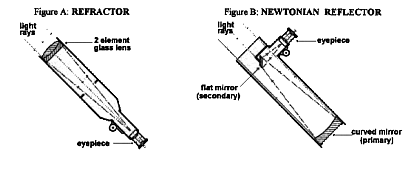
Telescope Terms:
Telescope performance depends primarily on the diameter of the main lens or curved mirror, whichever is used. This diameter is commonly known as the APERTURE. The larger the aperture is, the more light is gathered and the better the image will be. Aperture is usually measured in inches, with commonly available sizes being 2.4 and 3 inch refractors and 4.25, 6 and 8 inch reflectors. Another term used in describing telescopes is the FOCAL LENGTH. It is simply the distance from the lens or the main mirror’s surface to the point where the light comes to a focus. The two terms (aperture and focal length) are sometimes combined into the F-RATIO, which is just the focal length divided by the aperture. Thus if a telescope has a 6-inch mirror and a focal length of 48 inches, its f-ratio (or f/) is f/8. The f-ratio is often quoted instead of the focal length since it is a useful way of quickly stating what the focal length is regardless of the units of measurement for the aperture. The focal length of a telescope also helps determine another useful item, the MAGNIFICATION, or “power” of a telescope. The magnification of a telescope increases the apparent size of an object to a point where the human eye or camera can easily view it. Magnification is changed by changing the eyepiece being used. The “power” of a telescope is determined by dividing the focal length of the telescope by the focal length of the eyepiece, which is usually marked on the eyepiece barrel in millimeters. Thus if you had a telescope with a focal length of 48 inches (1219 mm) and were using an eyepiece with a 9 mm focal length, you would be using about 135x, and the object being viewed would look 135 times larger than it does to the unaided eye.There is a catch to using high power! Higher magnification, while making the object appear larger, spreads out the light gathered by the telescope over a larger area resulting in a fainter image. Also, because of the restrictions imposed on eyepiece design, you may only see part of that big image due to the smaller “field of view” high powers give you. Very long f-ratio telescopes can give you higher power with a given eyepiece, but you may not be getting much out of those powers if the light is too spread out. You have to compromise to get the best results.
At this time we must cover a very important point:– Do not be fooled by an advertiser’s claims of a “high-power” telescope!!! There is no theoretical limit on power, but there is a practical limit beyond which the images obtained are worthless. Because of the way light behaves, the MAXIMUM USABLE POWER is about 50 times the diameter of the main mirror or lens in inches or 50 POWER PER INCH of aperture. Using magnifications much beyond this will make the picture dim and very very fuzzy, like using a microscope on a newspaper picture or blowing up a photograph too much. For example, a common 2.4 inch refractor has a maximum usable power of about 120x, but we frequently see ads in major catalogs or retail chain stores advertising this same telescope as having “over 400 power !!!”. You would have trouble seeing anything at 400x in such a small instrument, although it might perform well at low magnification. Most astronomical objects except the moon and planets require very low powers to be seen at all, so the so-called “high power” would do you little good. In short: don’t buy a telescope just because it is advertised as having “high power”. Aperture and quality in a telescope are worth much more than power any day.
Telescope Types: Which is Best? The least expensive types of telescopes (small refractors and Newtonian reflectors) both have many advantages and disadvantages. The Refractor is probably the first type of astronomical telescope most people encounter so we will deal with it first. Because different colors of light are bent differently, a refracting telescope must use a special compound main lens which consists of at least two lenses of different shape and glass type to correct for this unequal bending (known as Chromatic Aberration). In addition, all of the glass surfaces must be coated with a thin layer of material which enhances contrast and reduces unwanted reflections. The main lens is mounted firmly at the front of the telescope tube, and when the eyepiece is in place, the tube is closed, keeping dust or air currents out. Refractors require little maintenance, although they must be handled with care to prevent scratching or damaging the delicate coatings on all the glass surfaces. They provide good high-contrast images, and are fairly popular with those who observe the moon and the planets exclusively. Their major good and bad points are summarized in the following chart.
Refractors
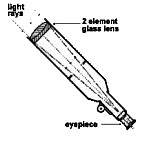
Advantages
Closed tube means no air currents which could degrade the images. Gives very good images and long focal lengths allow the use of less expensive eyepieces.
Disadvantages
Much more expensive than reflectors. Must use a 2-element main lens. Tend to be fairly long physically, (fairly long focal lengths). Awkward to look through for objects high in the sky unless star diagonal is used. Difficult to build by amateurs at home.
None of these disadvantages are terribly critical. The Newtonian Reflector also has some disadvantages, but it has many good points as well. It uses a specially curved aluminum-coated glass mirror to gather and focus the light, and a flat second mirror to direct the light out the side of the telescope tube and into the eyepiece. The Newtonian is an inexpensive fairly simple design which can be easily constructed at home, and is quite rugged. Its open-ended tube does allow air currents to sometimes degrade the images, and dust can settle on the mirrors, requiring careful cleaning periodically. Its strong and weak points are summarized as follows:
Newtonian Reflector

Advantages
Much less expensive than the refractor. Easy for the amateur to build at home. Very popular. More compact than most refractors (short focal length). Works well on a simple mounting. Easy to use when looking at objects high in the sky.
Disadvantages
Open tube means dust can get on the thin metal coatings of the mirrors. Mirrors sometimes need to be re-aligned after the telescope is transported or handled roughly. Secondary mirror blocks some light, and its supports cause small spikes on star images (not really much of problem). Cannot use cheap eyepieces.
A refractor may give slightly better high power views than a reflector, but the refractor can cost well over three times as much as a reflector of the same size! It is for this reason that most amateurs prefer the Newtonian reflector over the refractor for apertures larger than four inches.
Other Telescope Designs: A newer design which has a price somewhere between that of a refractor and a reflector is the so-called CATADIOPTRIC, or “mirror-lens” telescope. It uses a curved main mirror, an oppositely curved secondary mirror, and a special large correcting lens out front to obtain sharp images over a wide field of view. Catadioptric telescopes offer large aperture performance in a package that in some cases is small enough to sit on a table top! Their portability makes them popular with those advanced amateurs who don’t have room for a large Newtonian or refractor, but their price usually makes them out of reach of most beginners’ pocketbooks. You may see them listed under the names “Schmidt-Cassegrain”, or “Maksutov”, each of which uses a somewhat different optical design to do the same thing.
Telescope Mountings: Most astronomical telescopes cannot be hand-held like binoculars, so some sort of mount or stand must be used to hold the instrument and allow it to be pointed at any object in the sky. There is nothing more frustrating than having a good telescope on a mount that makes the images jiggle and dance every time the wind blows, so a good solid steady mount is a must. Many cheap telescopes found in stores have small metal tripods with thin legs and small screw-tightened pivot points for bearings. We call these “pillar and claw” mounts and they are the worst possible way to mount a telescope. The single tiny support bearings are so small that the telescope vibrates like a tuning fork when touched. Most camera tripods are almost as bad. The mount must be designed to support the telescope well and to damp out vibration while at the same time make the instrument easy to point. There are two basic types of mountings: the Altazimuth (figure C), and the Equatorial (figure D). The altazimuth is a good simple design that allows the telescope to tip up and down and to rotate around in a circle somewhat like a gun turret on a ship. It can point at any area in the sky and is easy to use especially for the beginner. The equatorial mount is the design favored by serious amateurs because it allows the instrument to follow the motion of the stars using movement around one axis instead of two. If equipped with a device called a clock drive, it will follow the stars automatically without the user’s help. This is a real convenience at high powers where the earth’s rotation causes many objects to drift out of the field of view in only a few seconds. The equatorial is heavier, a bit more expensive, and somewhat harder for the beginner to get used to than the altazimuth. Both mounts will work well if the bearings are large enough and the tripod or pedestal used with the mount is sturdy.

Telescopes Available and Prices
Binoculars: Binoculars are really two small refractors mounted side by side that use special prisms to “fold” the optical path of the light and make the instrument very short. They are described by two numbers (ie: 7 x 35), the first giving the magnification and the second giving the diameter of the main objective lenses in millimeters. In astronomy, binoculars can be used to see many more stars than the eye alone can, revealing many faint star clusters, nebulae, and even a few galaxies. Camera tripod mounts for binoculars are also available, and they help make the view steadier and more comfortable during longer viewing sessions. Binoculars will show many of the larger craters on the moon, as well as the four brightest moons of Jupiter. Their wide field and low power make binoculars an excellent choice for studying the brighter comets that occasionally appear. They also have the advantage of a right-side up image, something most astronomical telescopes don’t have. For astronomy work, we suggest the 7 x 50 wide-angle binoculars available for as low as $90. Binoculars can’t show you as much as a telescope, but they are an excellent way to get your feet wet in the hobby of amateur astronomy.
Refractors: There are basically two sizes of refractors that are suitable for beginners: the 2.4-inch (60mm) refractor, and the 3.1 inch (80mm) refractor. The 2.4-inch is the most common and is available in various focal lengths and on both types of mounts. The 2.4-inch runs from about $170 for an altazimuthly mounted 700mm focal length, to about $350 for a 900mm focal length equatorially mounted instrument. The 3.1 inch is considered an instrument for serious amateurs and is usually mounted equatorially for about $450 to $600. Many refractors smaller than 2.4 inches are often poorly made and generally not worth the money, except as small spotting or finder telescopes. Refractors larger than 3.1 inches are also available, but they are rather expensive. Most of the small refractors are made in Japan and come with a small telescope or “finder” mounted on the side of the refractor, as well as with one or two eyepieces.Finders are a must since the main telescope frequently has a fairly small field of view making pointing it at anything without using the finder very difficult. A 60mm refractor with a 20x to 60x zoom feature may also a good buy since it uses fewer eyepieces.
Reflectors: The two most popular sizes for the beginner are the 4.5 inch and 6 inch reflectors. The 4.5 inch size comes in a variety of focal lengths from 17 inches (f/4 “rich field” telescope) to 45 inches (planetary scope), and most are in the $250 to $500 price range. The good ones come with a finder and several eyepieces along with a Barlow or “booster” lens for higher powers. Newtonian reflecting telescopes are generally impractical in sizes under 3 inches and we know of few quality reflectors on the market under 4 inches in aperture (most are just junk mounted on the infamous “pillar and claw” mount, so beware of them). If you are at all handy with tools, you can buy the optics for the 4.5 inch scope in a kit and build the telescope using wood, plumbing fixtures, and a few spare weekends of time. Your total cost can be fairly low, and plans or parts sources can be found on many Internet sites or in Sky and Telescope and ASTRONOMY magazines.
One of the most popular telescopes among amateurs is the 6 inch Newtonian. It offers good light grasp and allows a wide range of powers at a fairly reasonable cost ($400 bare bones to $800 for one fully equipped, equatorially mounted and clock driven). These telescopes can be home built for under $300 and hold their resale value well. Large altazimuthly mounted short focus Newtonians commonly known as “Dobsonians” are also inexpensive with many 8 inch models selling for as low as $500. Their short f-ratio means they must use somewhat more expensive eyepieces. Also, many do not come with finders.
Buying Telescopes: Some camera or hobby stores have in stock or can order some of the more popular telescopes and accessories. However, there are no “telescope stores” in this area where you can go to see the full range of products from a variety of manufacturers. Some department stores sell a few 2.4 inch refractors, but be very careful when buying one of these. You should beware of any retailer making exaggerated performance claims (ie: over 120x for a 2.4 inch refractor). Check to see whether it has a good sturdy mount and clear crisp images at high power. Excessive color fringes around bright objects can mean poor optics, so look through the telescope before you buy it (the main lens should be called an “achromat” by the manufacturer). Also, make sure the finder gives good images and is mounted securely with metal, rather than plastic.Most amateur astronomers in this area buy from mail order companies that advertise in magazines such as Sky and Telescope or ASTRONOMY (available at local libraries and bookstores). Most of these firms are reputable and sell quality instruments, parts, or accessories. These magazines also have classified ad sections where used equipment is advertised, often with much lower prices than new instruments. The local Astronomy club is also a good source of information on new as well as used equipment. Occasionally, newspaper ads or garage sales can prove fruitful in the search for used telescopes.
Some Recommendations: For a young student or a beginner who is not sure of his/her interest in astronomy or who doesn’t want to spend much money, we recommend a short focal length (700mm or so) 2.4 inch (60mm) refractor on a good sturdy altazimuth mount. Also, binoculars are a good choice for stargazing as well as for other more down-to-earth uses.For the older child or for someone interested in astronomy as a part-time hobby, the 4.5 inch reflecting telescope is a good choice (from f/4 for wide angle views to f/10 for higher power lunar and planetary viewing). For the person with a serious interest in astronomy who wants to start seeing the sights immediately, we recommend a 6 inch “Dobsonian” Newtonian reflector on an altazimuth mount. The person who likes building things may want to build their own telescope from scratch or from parts and optics that are commercially made. A great deal of money can be saved by building, and the builder can take real pride in a customized instrument of his own making. A monthly column on telescope making appears in Sky and Telescope and there is even a magazine that deals with telescope making only. About a third of all telescope owners make their own instruments. The local Astronomy club can show you the many different approaches people have to instrument design and construction.
Reflector with Dobsonian mount
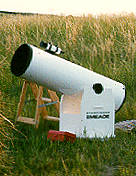
Refractor on equatorial mount
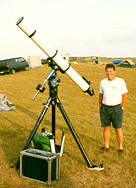
Reflector on equatorial mount
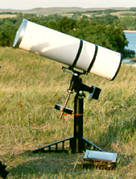
Schmidt Cassegrain with fork mount
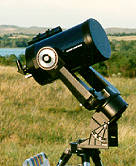
References: Small telescope users who become more interested in the sky often want to move up to a larger telescope quickly. People should be cautious here because getting taken in a deal for a larger instrument can cost a bundle! Members of your local Astronomy club own many different types and sizes of telescopes and are usually happy to show them to anyone interested. And above all, remember, when you do get your telescope, USE IT! If you have trouble setting it up or using it, the members of the Prairie Astronomy Club will be glad to help you.
The Prairie Astronomy Club, Inc. is a non-profit organization interested in observing the sky for personal enjoyment and public education. Meetings are held on the last Tuesday of each month at 7:30 p.m. at the Hyde Memorial Observatory, located in Holmes Park in southeast Lincoln. All meetings are free and open to the public. The club also holds monthly star parties where members and guests can use their telescopes at the club’s rural observatory south of Lincoln. For more information, come to a meeting or write to the club at P.O. Box 5585, Lincoln, Nebraska 68505-5585.
Books on Telescopes: These books are recommended for additional reading.
Telescope Handbook and Star Atlas, by Neal E. Howard. Published by Thomas Y. Crowell, New York, N.Y.
The Complete Manual of Amateur Astronomy, by Clay P. Sherrod. Published by Prentice-Hall, Englewood Cliffs, N.J.
All About Telescopes, by Sam Brown. Published by Sky Publishing Co. Cambridge, Mass.
Build Your Own Telescope, by Richard Berry. Published by Charles Scribner’s Sons, New York.
Making Your Own Telescope, by Allyn J. Thompson. Published by Sky Publishing Co. Cambridge, Mass.
Standard Handbook For Telescope Making, by Neal E. Howard. Harper and Row, New York.
Norton’s 2000.0 Star Atlas and Reference Handbook, by Ian Ridpath. Sky Publishing Co. Cambridge Mass.
A Field Guide to the Stars and Planets, 2nd ed. by Donald H. Menzel and Jay M. Pasachoff. (1983, Houghton-Mifflin Co.)
MAGAZINES: (Monthly publications about Astronomy and related subjects)
SKY AND TELESCOPE, (for both amateur and professional astronomers) published by Sky Publications, 49 Bay State Road. Cambridge, Mass. 02138.
ASTRONOMY, (for beginning to intermediate level amateur astronomers) published by Kalmbach Publishing. 21027 Crossroads Circle, P.O. Box 1612, Waukesha, Wisconsin 53187.
Other Buyer’s Guide Pages
Astronomics: How to Pick a Telescope
Orion’s Telescope Buyer’s Guide (lower right on their home page)
So You Wanna Buy a Telescope… Advice for Beginners
Credits
Written by David Knisely (Web-page version produced by Mark Dahmke) Input and final proofing: Lee Thomas, Ron Veys, Rick Johnson.